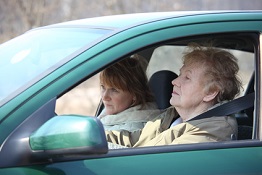 Recent research shows a daily routine of being active for 15 to 30 minutes can “empower” older motorists with better driving skills that are essential, from head-turning to check blind spots and back up a car to entering and exiting a car.
Recent research shows a daily routine of being active for 15 to 30 minutes can “empower” older motorists with better driving skills that are essential, from head-turning to check blind spots and back up a car to entering and exiting a car.
The Hartford and Massachusetts Institute for Technology (MIT) partnered in a study released this week that highlighted connections between driving performance and regular exercise.
According to the research, certain exercises were linked to certain driving skills:
–Strength: Control over braking is crucial to safe driving, which can be improved with biceps curls and squats.
–Range of Motion: Fastening a seat belt can be made easier with back stretches and heel drops.
–Flexibility: Entering and exiting a car easily can be improved with chest and shoulder expansions as well as shoulder stretches.
–Coordination: An “integration of movement” between the lower and upper body can be vital to more complex driving tasks like braking while turning at the same time. Soccer kicks and lateral steps can improve these tasks.
In the study, drivers between the age of 60 and 74 underwent a “physical fitness program” every day for between 8 and 10 weeks that focused on the four areas listed above.
A series of in-lab tests, driving simulations, and use of MIT’s AwareCar, a real-time, telemetric-equipped vehicle, assessed those drivers’ performance before and after the program.
“After completing the program, participants were able to get into a car more rapidly, demonstrating greater overall flexibility,” said Jodi Olshevski, executive director for The Hartford Center for Mature Market Excellence. “They also reported greater ease in turning their heads and bodies to back up to see their blind spots and were able to rotate their bodies further to scan the driving environment when making turns.”
A survey of drivers over 50 years old accompanying the study’s release showed that half of those surveyed hadn’t considered how more exercise could strengthen driving performance. Most of those surveyed (41 percent) chose “turning their head and body to look behind when backing up” as the most difficult driving task.
Yet many older motorists tend to hold on to driving as “essential,” according to Olshevski, as a “sense of independence and autonomy.”
“We should all be thinking about exercise as another way to stay safe on the road,” she said.
The study also provided an exercise guide and video that would “contribute to a more positive driving experience,” Joseph Coughlin, director for the MIT AgeLab, said in a statement.
Other Research Includes Best Tech for Older Drivers
The partnership between the auto insurance company and research university resulted in a study released last year that listed the top 10 car technologies that aid drivers over 50 years old:
–Smart headlights
–Emergency response systems
–Reverse-monitoring systems
–Blind-spot warning systems
–Lane departure warning systems
–Vehicle stability control
–Parking assist systems
–Voice-activated systems
–Crash-mitigation systems
–Drowsy-driver alerts
The Hartford and the American Association for Retired Persons (AARP) offers an auto insurance program for drivers over 50 years old, while AARP offers driver safety programs can net participating drivers a discount upon completion.
According to the Insurance Institute for Highway Safety, “fragility begins to increase” for drivers between 60 and 64 years old, before death rates begin a noticeable rise for drivers at 75 years old.